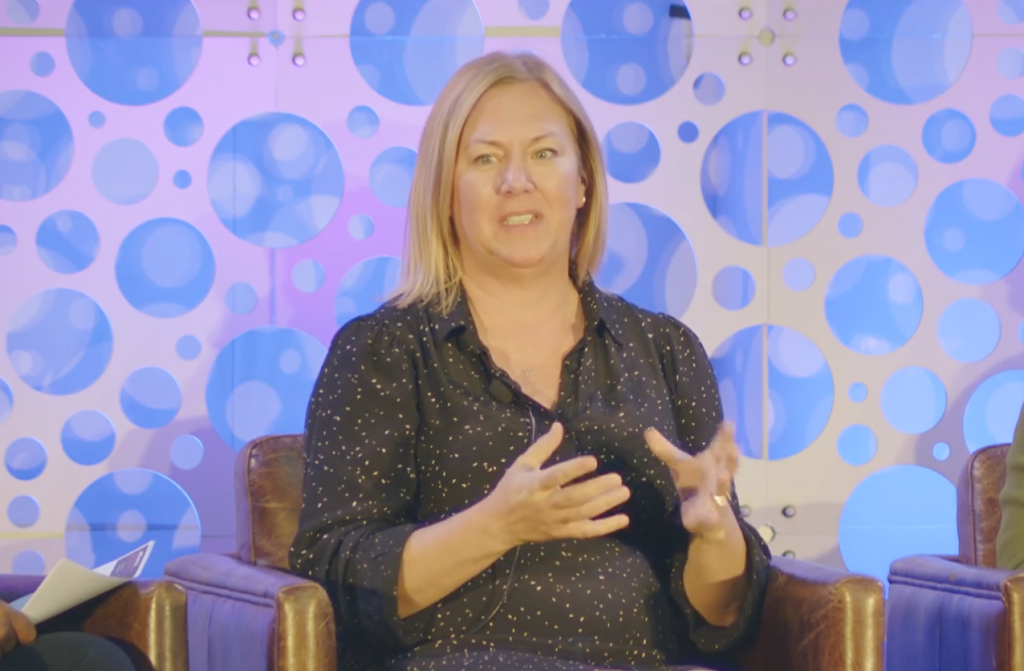
This is a recap of a session from AiDASH Evolve 2024
Summary:
- Utilities can build success by breaking technology and information silos and fostering digital maturity.
- Balancing biodiversity goals with operational goals is a must: Key approaches include aligning timelines and governance, leveraging price reviews, and tracking and communicating impacts to stakeholders.
- Natural capital and sustainability initiatives enhance public trust and engagement.
Is championing biodiversity a plus or minus for water and electric utilities? Leaders from three water and electric providers joined AiDASH VP of EMEA Shashin Mishra at AiDASH Evolve 2024 to discuss how they address Biodiversity Net Gain (BNG) and natural capital in their operations. The panel comprised:
- Carolyn Cadman, Director of Natural Resources, South West Water
- Kathleen Fillier, Environment Analyst, Newfoundland Power
- Jack Lomas, Emerging Technology Lead, Capital Design and Delivery, Severn Trent
Mishra curated the discussion as the panel revealed how they balance the needs of critical infrastructure with sustainable environmental stewardship. They examined the challenges and opportunities of embedding biodiversity into utility operations, including regulatory compliance, partnerships with landowners, and the use of technology to monitor and enhance natural capital.
Regulated or not, utilities set biodiversity and natural capital goals
Enhancing biodiversity is a part of the overall concept of supporting natural capital — all of the Earth’s natural assets, including air, land, soil, water, minerals, and all plant and animal species. South West Water and Severn Trent measure and improve biodiversity and natural capital per the UK’s Environment Act 2021 requirements, while Canada’s Newfoundland Power anticipates legislation and proactively works to support biodiversity and natural capital.
South West Water’s Carolyn Cadman noted that the Defra Statutory Biodiversity Metric tool plays a critical role in allowing the utility to measure biodiversity net gain. “The tool is really, really important to us because we need to be able to demonstrate to our investors, to our customers, and to our stakeholders and partners that we are actually delivering a measurable net gain,” she explained.
“In Newfoundland and Labrador, as a part of Canada, [BNG is] not something that’s been legislated yet, but we’re working to create our own goals and [are] working with our local regulators and legislation teams to…get ahead of the curve,” said Newfoundland Power’s Kathleen Fillier. She echoed Cadman’s approach of using BNG to show customers and investors that the utilities are using funds appropriately, sustainably, and to improve biodiversity.
Severn Trent’s Jack Lomas explained that biodiversity delivers environmental and asset resilience by:
• Providing natural protection for assets, which are already under much strain.
• Improving water quality in water courses.
• Enabling better customer welfare and experience.
Severn Trent provides water and wastewater services to about 4.5 million homes and has calculated that woodlands within its region prevent 650,000 cubic meters of flooding each year. “So that hopefully gives you an idea into how important biodiversity is from a flooding perspective,” he said, adding, “The biodiversity across our region also sequesters over 4000 metric tonnes of common CO2 equivalents per year.”
Balancing act: biodiversity versus operational/capital goals
Lomas said the challenge for Severn Trent is complying with regulations for putting new infrastructure in or above ground within 5-year regulatory cycles while meeting biodiversity obligations. At the center of this balancing act is information availability, he said, “so we can make more informed decisions around where the opportunities for enhancements lie.”
Cadman explained that water company culture can feel dominated by the engineers and accountants who speak in numbers and spreadsheets. “Adding carbon accounting into those conversations is quite challenging,” she said. “I think what [the Biodiversity Metric tool] has given me is a way of meeting those cultures in the middle. It helps me to quantify both in terms of cost and outcomes — what it is that nature can contribute to the water management challenges that we’re facing?”

One of the chief concern for utilities is maintaining reliable service, but as they address capital projects, stakeholder communication and building relationships are also key.
Fillier explained that early and thoughtful stakeholder communication helps them balance biodiversity requirements with delivering capital projects on time and on budget, and that establishing strong relationships with governing agencies has made it much easier to reach out to them when questions arise.
In fact, Newfoundland Power’s strong relationship with regulators has prompted them to make the utility a part of the consultation process, when regulations are in review or under development.
Align timelines and governance to maximize BNG
When it comes to setting milestones for BNG, Cadman explained that outcomes and the value of BNG milestones depend on habitat and type of intervention. Localized interventions can show results in as little as 3 to 6 months, whereas larger landscape-level enhancements may take years to manifest. Under new regulations for water companies, biodiversity performance is measured every 4 years, and the long-term BNG mandate is 30 years.
“You do your intervention, and then you measure the enhancement 4 years later, and every 4 years — and that’s when you take the credit, so to speak, against your targets,” she said.

Fillier observed the importance of clear timelines — whether government-mandated or self-imposed — in creating meaningful returns on biodiversity initiatives. And keeping track of impacts is essential.
“We all know that there’s no such thing as too much data when it comes to measurements and KPIs and metrics and all these things,” she said. “It’s important to keep a track of the impacts you’re having and communicate those to your stakeholders.”
Lomas pointed out the need for strong information governance to integrate ecological data into capital investment plans effectively. For example, he shared how Severn Trent worked to introduce the right type of information governance to be able to ensure awareness of all existing biodiversity net gain enhancements. “Otherwise, there is a significant risk that we could potentially build on where the previous enhancements have been. So, we want to very much ensure that we are protecting those 30-year environments as much as possible.”
By protecting and leveraging existing biodiversity efforts, utilities can safeguard the long-term success of their interventions.
Leverage price reviews and innovative strategies to advance biodiversity goals
The price review cycle, a key regulatory framework for utilities, significantly influences how biodiversity and nature-based solutions are integrated into project plans.
Cadman explained that PR24, the 2024 price review by Ofwat, focuses on driving lower-carbon, nature-based approaches for water companies in England and Wales. “The approach we’ve taken in South West Water is to really focus in the next 5 years on building additional evidence over and above the existing evidence to really convince our regulators that […] we’re going to go all-out on nature-based solutions,” she said.
This forward-thinking approach reflects a shift from conventional gray infrastructure—including manmade pipes, concrete channels, gutters, and drains—to greener, more sustainable methods.
Fillier highlighted a practical challenge: Biodiversity-related costs can escalate during linear development projects if ecological surveys are delayed until after regulatory approval. “To work biodiversity into that stage, we’ve begun to consider it before the project is even submitted for approval,” she said. “The route you choose for linear development has a direct impact on the cost of that linear development.”
When the regulatory framework doesn’t allow for upfront exploratory costs prior to project approval, biodiversity may require more mitigation and incur a significant cost. But technology can help.
She said that related technologies, like AiDASH Biodiversity Net Gain Management System™ (BNGAI™), allow them to do “a bit of desktop research” before they choose linear development routes. “And that gives us a bit more cost certainty when we’re submitting a project.”
Lomas underscored the opportunity that utilities have to embed digital technologies at the heart of investment programs. He explained that tools like BNGAI allow utilities to make BNG initiatives more targeted and impactful, ensuring resources are allocated effectively.

This alignment of technology with regulatory cycles paves the way for large-scale environmental and financial benefits. “We can then be as effective and targeted in where we invest … I think that offers a really exciting opportunity to do things on a massive scale and make a huge impact,” he said.
Digital maturity is essential, and so is breaking down silos
As utilities adopt new technologies to drive biodiversity net gain, organizational digital maturity — including the elimination of silos — plays a pivotal role.
Cadman explained that while companies like South West Water operate in some of the most beautiful environments, their internal systems for customer management, environmental efforts, and capital programs can be disconnected. To maximize the impact of digital tools, she envisions more integrated systems that not only streamline internal processes but also enhance the company’s reputation.
“I’d like to think that we will join those things up … so that we are definitely seen as a catalyst for positive change and an attractive place to work,” she said.
Fillier also highlighted the importance of breaking down silos within Newfoundland Power. By ensuring technologies used in one department can benefit others, the company has optimized its resources and improved accessibility.
She said their technology team has done an excellent job with that in the past few years by “Breaking down the silos between the functional areas of the company, and making sure that the technologies we’re using over here, if they’re helpful [elsewhere] as well, we can share that, and we can maximize the benefit of the technologies that we do have.”
Lomas emphasized that digital maturity is central to addressing the BNG challenge, particularly as capital investment programs grow in complexity. With limited ecological resources, he argued that embedding digital solutions into operations is not just optional, but essential, to meet the BNG challenge.
“It’s really an information challenge. It’s understanding where across our region we can make the right types of investments and enhancements,” he said, highlighting the overwhelming scale of paperwork at Severn Trent, where thousands of permits are submitted daily. He sees digital tools as a way to streamline and standardize these processes, enabling scalability and meeting regulatory obligations more efficiently. “It’s a really, really basic sort of evolutionary step in our day-to-day operations, but I think it presents a massive opportunity,” he added.
Potential for using natural capital and sustainability initiatives to shape public perception
Public perception plays a critical role in how environmental improvements are implemented and received.
Cadman highlighted the challenges that water companies in the UK face, where idyllic landscapes mask ongoing ecological and climate crises. Media attention on sewage overflows into rivers and seas, particularly in popular swimming spots, has heightened community anxiety and eroded trust in water utilities. She pointed to natural capital initiatives as a way to regain public trust by providing measurable evidence of environmental improvements and situating these within broader contexts like industrial and agricultural pollution.
Check out more sessions and information from Evolve 2024, and reach out to see BNGAI in action!
The best collection of tools, tips, guides, and industry stories – straight to your inbox.
Subscribe to our newsletter
